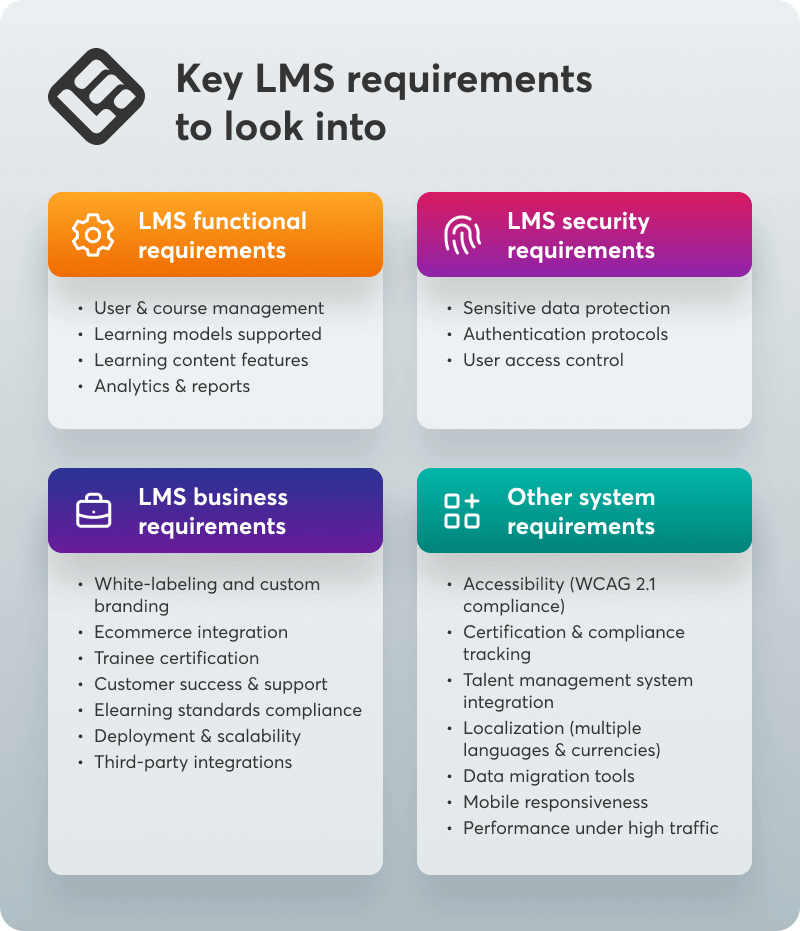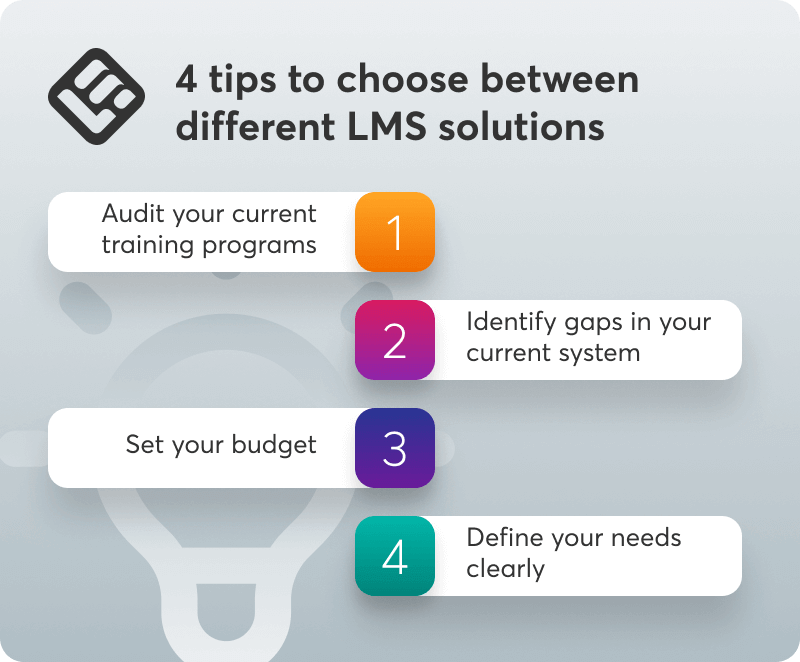Table of Contents
Very early into my LMS discovery journey, I thought all LMSs did the same things. Fast forward a couple of years, and not only has my own perspective changed, but the market offering has as well.
Finding the right LMS today goes beyond checking off boxes. But don’t worry. We’ll still go together through all the must-haves your next LMS needs to bring to the table, and I’ll also let you in on a couple of extra tips. These will let you pick a tool based on your user types, specific business goals, and security requirements.
Below, you have a table that condenses the must-have LMS requirements in 2025, based on functional, business, security, and technical LMS requirements that carry the most importance this year.
With these requirements clearly defined, you’re ready to select or build an LMS that meets your organization’s goals. Thoughtful planning now will help ensure a smooth implementation and long-term success.
Core learning management system requirements
The essential elements of the right learning management system define how organizations promote engagement, align business value drivers, and maintain compliance in a digital-first environment.
Your LMS is first supposed to consolidate learning, make the user experience more personalized through AI, and deliver analytics that let learners and admins stay informed. Add-ons shouldn’t be standard either. Users want extensive integration with other business systems, mobile-first accessibility, and complex collaborative spaces on all fronts.
Organizations also need to focus on LMS solutions that provide modular content and user management based on in-app activity and compliance tracking automation. The platform’s ability to adapt to your needs, let you switch between online learning models, and manage a variety of users also extends its value.
LMS functional requirements
A strong LMS should be able to simplify registering and segmenting users, allowing you to deliver flexible content in multiple forms and connect it with other platforms you’re using for other use cases (like apps for hosting webinars or live video conferencing tools).
As promised, below is an extensive list of the important functional requirements of an LMS provider you should focus on for corporate training. I’ve broken down each core module into the smaller capabilities that will influence your day-to-day workflows.
User and course management
Learning models supported
Online learning content features
Analytics and reports
💡Read also:
LMS business requirements
Trainee certification, adherence to industry standards, and responsive customer support are givens. Here are the top priority LMS business requirements.

White-labeling and custom branding
Ecommerce integration
Trainee certification
Customer success and support
Elearning standards compliance
Deployment and scalability
Third-party integrations
LMS security requirements
With 83% of organizations managing their LMS internally and 98% of large organizations adopting LMS platforms, robust security and compliance features are essential to meet regulatory and privacy demands.
The security of your LMS is based on these three components: data security, authentication, and access control. Let’s explore these in detail.
Sensitive data protection
Authentication protocols
User access control
Other system requirements
Besides regional compliance, certain sectors such as finance or healthcare also come with their own specific requirements. Here are a couple of the ones you can’t skip.
Accessibility (WCAG 2.1 compliance)
Certification and compliance tracking
Talent management system integration
Localization (multiple languages and currencies)
Data migration tools
Mobile responsiveness
Performance under high traffic
LMS comparison chart
Next, I’ve prepared a side-by-side comparison chart of the leading LMS platform options, together with their G2 scores, top use cases, and main features.
Thanks to these LMS offerings, companies can choose a solution that aligns well with their personalized training requirements and objectives. Each corporate LMS has different advantages, and in that way, they can fit different learning contexts and business models.
💡Read also: 10 best LMS for small businesses
Check out the following platform comparisons to learn more:
LMS requirements checklist by organization type
Small and midsize businesses will lean towards ease of use, budget, and how well the LMS integrates with systems they’re already using.
Multi-tenancy, custom branding, and advanced analytics come in handy for enterprises serving a vast list of partners, vendors, or customers. Schools will also be concerned with academic workflows, blended learning, and adherence to education standards.
The following LMS requirements types table lists the primary requirement types of each company, allowing you to find the features you need the most.
With this LMS requirements matrix and the sector-specific criteria defined, you can more effectively evaluate LMS solutions that align with your organization’s operational context and compliance needs.
Choosing an LMS isn’t about just ticking boxes for today, but building the system that you need to scale with your team’s evolving skills. We don’t train freelance filmmakers and photographers just once; we invest in their lifelong learning. Which is why we went with an LMS that could handle the bite-sized microlearning (such as 5-minute tutorials on new lighting styles), subscription-based access so our creatives can come back to courses whenever they want, and digital badges to validate their skill set to our clients.
Andrew Cussens, Digital Marketing Specialist, Founder & CEO at FilmFolk
As regulations on compliance evolve, your LMS needs to be more flexible to absorb new training needs or new compliance regulations into it without the need to redesign the whole system. Besides flexibility, other features required include integrating with the other compliance tools. Take for example your LMS, must be well integrated with document management systems and audit tracking tools in order to make sure that the training records are well taken care of and reachable during auditing.
Allan Murphy Bruun, Chief Revenue Officer & Co-Founder at SimplerQMS
Documenting LMS system requirements
Writing down LMS system requirements will let you first focus on creating learning experiences that follow your industry regulations and meet your users’ expectations.
In a well-managed documentation, you’ll want to start by outlining the vision and scope of your learning requirements.
What is it that you want to achieve by using a new LMS? Are you looking for stronger student engagement? Or maybe you want to start selling courses.
For instance, identifying integration needs with existing HR, CRM, and analytics systems is also an important step to maximize the benefit of your LMS investment and facilitate future scalability.
Once you have this vision in mind while documenting LMS requirements, you’ll be able to document exactly what LMS system requirements you need. Use my extensive list above and define common workflow scenarios and integration requirements based on who will be using the learning platform.
How to choose between different LMS solutions
Before this vision comes to life, you’ll need to put together a budget, factoring in not only the platform cost (such as licensing) but also implementation, ongoing support, maintenance, and so on.
Here’s where to start.

1. Audit your current training programs
Begin with a serious inventory of your current training programs. This includes:
This three-step exercise offers a good starting point for what your organization already has in motion and what’s worked so far.
2. Identify gaps in your current system
Time to see exactly where your current tool and LMS development process fail. Keep an eye on the actual LMS features that don’t deliver their promise, missing elements, or outdated tech that could be holding you back.
Check if your current LMS accommodates various learning models (eg mobile learning or blended learning) and consider if your current training covers all the appropriate skills to meet the changing needs within the organization. Mobile learning is a key driver, with the mobile learning market expected to reach $287.17 billion by 2030, growing at an annual rate of 24.78%.
3. Set your budget
Setting a budget you can afford is also important. Be sure not only to factor in the upfront cost of the license or subscription but also the costs of implementation, customization, ongoing support, and turning your training into content.
Ready to scale? That might come with extra costs you need to take into account.
4. Define your needs clearly
By now, you should have a rough list of the features and integrations you can’t live without. But also think of the various types of end target audiences who may need to access the LMS (e.g. admins, instructors, learners) and document their own reporting and support requirements.
💡Learn more: How to choose the best learning management software for your business in 2025
LMS implementation checklist
With my very first LMS implementation, I built my own checklist as I was figuring things out. This resulted in a lot of missed steps, though.
You don’t have to go through that, as I’m sharing my go-to LMS implementation checklist, compiled from years of actual experience and industry best practices:
When you’ve gone through these steps, your organization will be ready to get the most out of your new LMS.
Get the best learning management system functions with LearnWorlds
LearnWorlds gives you a first-hand look at how easy it is to create training materials and sell your online courses. The platform stands out through its user-friendly interface, robust interactive course editor, and general freedom to support a variety of content types from self-paced learning to live webinars and blended learning programs.
Whether you’re a coach, academic organization, or company, you can create branded, scalable learning experiences based on one simple concept: interactive video meets AI-powered tools to adapt to your learners’ needs.
I also love how LearnWorlds makes it so fast to organize compliance tracking and certification management, which can save you hours of work and help keep teams prepared at all times.
Start a free trial today to explore all of its capabilities.

Alexandra Cote
Alexandra Cote is a SaaS growth marketer and online instructor who's worked with dozens of brands in the MarTech, HR tech, and productivity space. She's also a strong supporter of staying happy at work and choosing a healthy career path.
FAQ
Everything you have ever wondered, but were too afraid to ask...




